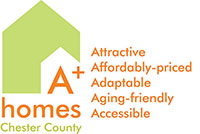Challenges
Changing Demographics
Shifting demographics are altering the way people use and interact with housing.
The population is growing.
Chester County has grown rapidly, adding nearly 250,000 people since 1970, which is about a 90% growth rate. Current DVRPC forecasts show the county adding 146,000 people by 2050 for a 27.7% increase over the base year of 2020.
To accommodate new population growth, the county will need to add approximately 51,500 new homes by 2050.
Household types are shifting.
"Nuclear families," defined as two parent households with children, traditionally comprised a large sector of the population. At a national level, demographics are shifting away from nuclear families. While nuclear families accounted for 43% of all households nation-wide in 1950, that percentage decreased to just 20% of households in 2015. Pennsylvania and Chester County have both seen similar demographic changes.
The nuclear family household is being replaced by household compositions including one-person, couples without children, single-parent, parents living with adult children, siblings cohabitating, empty-nesters, and unrelated adults cohabitating.
These demographic changes and affordability challenges will require more and new forms of housing to be constructed in the county.
Affordability Crunch
Chester County has the highest median sales prices in the state, and median housing sale prices in Chester County have been steadily increasing since 2009. In 2020, the median sale price for all homes in Chester County increased to $375,064, up from $355,000 in 2019, and in 2021 the median sale price further increased to $420,000. Median sales prices for detached single family units were even higher in 2021 at $475,000.
Median Home Sale Prices
As housing prices increased, the percentage of home sales in the affordable range of under $250,000 has continuously decreased.
Home Sales Percentage
Historically, income and housing prices increased at similar rates, however, in recent years incomes have not kept pace with rising housing costs.
Median Home Sale Prices and Median Income
Housing prices have outpaced inflation and income growth in the county, causing affordability issues. Younger residents are unable to afford homes, aging individuals are not able to afford ongoing housing costs, and employers are struggling to attract employees.
Zoning
Missing middle housing types are not permitted by zoning in much of Chester County's residentially zoned areas.
Landscapes3, Chester County's comprehensive plan, provides a guide for future growth and rural resource protection in Chester County. The plan identifies both Growth Areas, centered around existing developed areas, and Rural Resource areas. The county Growth Areas are best suited to accommodate the bulk of future residential development. Growth Areas include four unique categories: Urban Center, Suburban Center, Suburban, and Rural Center. While missing middle housing is appropriate in all Growth Area categories, the typologies and forms are a function of the local character.
The Chester County Planning Commission completed an analysis of land where missing middle housing is permitted by zoning in Urban and Suburban centers. The analysis was completed for nine of the twelve identified missing middle housing types appropriate to the county; accessory dwelling units, single-family conversions, twins, townhomes, duplexes, triplexes, quadplexes, multiplexes, and live-work. Right of way (including roads) was removed for the analysis to account only for land where homes could be built. The analysis focused on land zoned for residential and mixed-use development; land not currently allowing residential uses (such as industrial and heavy commercial) were omitted from the analysis.
Most municipal zoning does not encourage missing middle housing. On average, missing middle housing types are allowed in 38% of residentially zoned land in suburban and urban centers at all (by-right, special exception, or conditional use), and only 23% by-right.
The Chester County Planning Commission completed an analysis based on average housing type size. Developing all the remaining residentially zoned developable land in urban and suburban centers (see Landscapes3 Map) as twins — the lowest density missing middle housing type — would result in 13,360 more units than developing the same land as single-family detached. Developing the land as multiplex units, the highest density missing middle housing type, would result in 37,152 greater units than developing the same land as detached single-family housing.
However, current residential zoning is limiting the potential benefits of missing middle housing development. Twins are only permitted in zoning in 37% of developable residentially zoned land in urban and suburban centers; this land could accommodate a potential 5,834 twin units compared to 15,770 units accommodated by all residentially zoned developable land in suburban and urban centers. The current residentially zoned developable land in suburban and urban centers allowing multiplexes by-right could only accommodate 6,278 units compared to the potential 39,362 units the land could accommodate. Expanding where missing middle housing types are allowed by-right would better accommodate the projected population growth.
Resident Opposition
Municipalities are facing increasing resident opposition to new housing development in their communities.
Resident concerns stem from both real and perceived negative impacts of new housing. Concerns can include changing community character, additional school children, increased traffic, and reduced open space. Residents’ concerns about community character is particularly applicable to missing middle housing. Missing middle housing types are commonly built throughout Chester County, although they can be found predominantly in the boroughs. Small townhomes, twins, medium-multiplex, single-family housing conversions, adaptive reuse, and accessory dwelling units are the most common missing middle housing types in the county. Visual examples of missing middle housing types can be found in the opportunities section of this guide.


